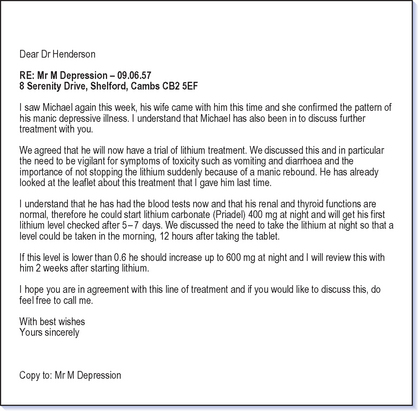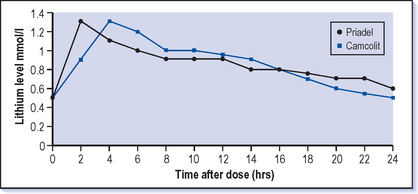5 Lithium and long-term prophylactic treatment
LITHIUM
5.4 How effective is lithium?
The more statistical view of group effects is that lithium will reduce the rate of relapse by 20-30% (Fig. 5.1). The relapse rates in most trials are about 50% over a year on placebo and this is reduced to about 30% on lithium. However, it is difficult to translate this figure to individuals.
5.5 What are the indications for lithium treatment?
Lithium is occasionally prescribed for certain forms of headache (e.g. cluster headaches).
5.6 Who should be taking long-term preventive treatment for bipolar disorder?
If someone has had even a single, severe, highly disruptive episode of mania or severe depression then it is tempting to suggest that they should take long-term treatment and indeed a few patients do this. However, after one episode it is very uncertain when the next episode will occur (though it almost certainly will occur at some time, see Q 2.18) and most people will not want to undertake a very long-term treatment at this stage.
5.9 How dangerous is it?
However, when the levels are kept below 1.2 mmol/l then lithium is very unlikely to cause long-term harmful effects on either the brain or the kidney. Usually those that suffer from toxicity do so because the levels have slowly gone up rather than in an acute overdose. Although lithium is obviously known to be dangerous at high levels it is surprising how rare overdoses of lithium seem to be, especially given that it is prescribed to a group that is exceptionally vulnerable to suicide (see Q 5.26). This may be because it is a very effective treatment and also that it may have a specific antisuicidal effect. However, the most serious adverse effects of lithium toxicity do seem to occur among those who deliberately take a large overdose of slow release tablets where the levels continue to rise long after ingestion even if they have vomitted.
5.10 What are the symptoms of lithium toxicity?
Levels can reach as high as 5.0 mmol/l and fatalities and permanent physical damage can be expected.
5.12 What needs to be done prior to initiating lithium treatment?
Ensure that the patient has been given a leaflet outlining lithium treatment (see model in Appendix 3) as they will not remember enough from a conversation. Stress the symptoms of toxicity that need to be recognised, and also that careful use of lithium and good monitoring will prevent toxicity occurring. An example of specific instructions from the hospital about how to start treatment are shown in Figure 5.2.

Fig. 5.2 Example of a letter from a consultant to both GP and patient about starting lithium treatment.
The other important piece of information the patient should know is that this is a long-term treatment and sudden cessation of lithium can lead to rebound mania and so a worsening of the illness course (see Q 5.27). This means that the illness can be made worse by taking lithium intermittently than it would have been if the patient had never taken the treatment at all!
5.13 How is lithium treatment initiated?
Assuming that preliminary checks have been made (see Q 5.12) and renal function is normal, the usual routine for beginning lithium treatment would be to start at 400 mg at night and then check a blood lithium level at 5 days. It is likely that the initial target blood level will be 0.6 mmol/l and benefit will be judged at this level. If the blood level at 5 days comes back at less than 0.6 mmol/l the lithium dosage should be increased by 200 mg and checked again at 5 days. This process should be repeated until the desired level is reached. When a stable dose has been reached, continue to monitor every 2 weeks for 1 month, then monthly for a further 3 months and 3-monthly thereafter.
5.14 Why is lithium usually prescribed to be taken all at night?
There is no good therapeutic reason for taking lithium at night–it is no more effective then than if taken at any other time. However, side-effects are generally more prominent at higher blood levels which tend to be in the first few hours after taking the tablet (see Fig. 5.3), so it can be preferable for the patient to be asleep at this time. For compliance reasons taking tablets once a day is usually better (see Q 5.43).
5.16 What monitoring needs to take place while on lithium treatment?
When the patient is on a stable dose of lithium, checking lithium levels every 3 months is adequate; checking renal and thyroid function every year is also needed. Weight gain can be a problem with lithium and keeping an eye on this from the start rather than waiting until the patient has gained weight is worthwhile. There have been reports of hyperparathyroidism with lithium and some advocate checking calcium levels annually as well (Drug and Therapeutics Bulletin 1999).
5.18 What blood levels should I be aiming for?
The therapeutic range that is routinely aimed for is 0.4-0.8 mmol/l in the serum at 12 hours after the last dose (Fig. 5.3). When lithium was first introduced into psychiatry, higher levels of up to 1.2 mmol/l were commonly used but over the years the level aimed for has tended to be lower. This is probably because doctors have become more concerned about toxicity, even though with care higher levels can be maintained safely.



